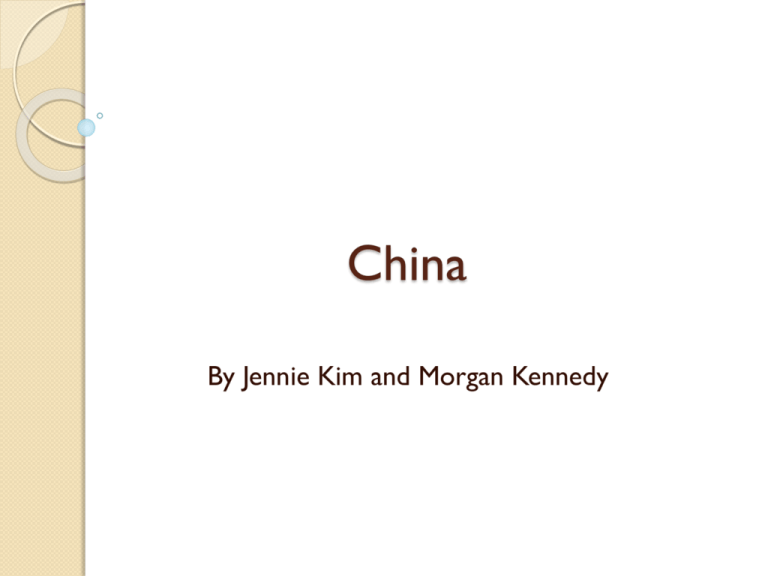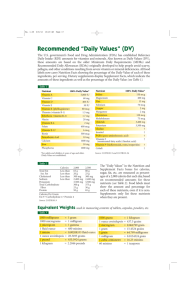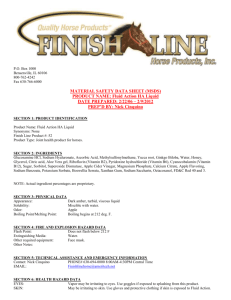File - Jennie Kim's ePortfolio
advertisement

China By Jennie Kim and Morgan Kennedy Introduction Why we choose China ◦ We both have a strong interest in the culture Jennie loves Chinese food, and Korean food, which is a big part of her life, has its roots in Chinese culture. Traveling to Hong Kong is on my bucket list! I find the culture intriguing because of the contrast to my culture. Family Traditional family has a patriarchal authority (1). ◦ Eldest son marries and continues living with his parents; younger siblings marry and leave the household. Now, more parents and grown children prefer not to live together but remain near each other. ◦ More commonly applies to middle-aged parents. ◦ Those who live together do so mostly for economic support and caretaking. Education is highly valued in Chinese families (2). ◦ Parents tend to be less satisfied with their child’s achievement level. ◦ Teachers are much more important than parents when it comes to their child’s academic performance. ◦ Self-improvement, collectivism, group identification Religion: Background Confucianism, Taoism and Buddhism are interconnected (3). All three co-exist in one’s life, sets the foundation for a holistic approach to life Religion: Impact on Diet ◦ The heightened awareness of life’s dual nature had direct effect on diet (4). ◦ Food is believed to have a great impact on one’s balance. ◦ Foods are categorized as yin or yang and hot or cold, these definitions can vary by region. Traditional Food Habits Eating is a communal affair (5). ◦ Family sits together: bowl, plate, chopsticks ◦ Share dishes, greet each other ◦ Eldest person may take first bite of the meal Staples ◦ North: wheat (buns, noodles, pancakes), sweet corn ◦ South and East: rice ◦ West and Central: sweet corn Frying is the preferred cooking style ◦ Other common methods: sautéing, boiling, steaming, braising, smoking, stewing Yin and yang balancing ◦ Yin = cold foods (ice cream, watermelon) ◦ Yang = hot foods(garlic, chili peppers) ◦ Also applies to climate and geographical area Health: Background Health beliefs and practices are strongly influenced by religious beliefs (4). Emotional state is reflection of health status Holistic approach to medicine Elements Organs Fire Heart Earth Spleen Metal Lung Water Kidney Wood Gallbladder Health: Growing Rate of Obesity 1992-2002 (6). ◦ 50% increase in overweight Overweight and Obesity Definitions children (15% to 23%) World Health Working Group on Obesity in ◦ 150% increase in obesity Organization (WHO) China (WGOG) (2.6% to 6.4%). 2002-2010 Overweight = BMI > 25 Overweight = BMI > 24 ◦ Overweight 25% to 38.5% Obesity = BMI > 30 2005-2011 ◦ 18 million obese ◦ 100 million obese Obesity = BMI > 28 Health: Chinese in the U.S. Increased prevalence of chronic disease of Chinese living in the United Sates verse China (7). The greatest influence of dietary change are food availability, cost and convenience (8). Educational programs should focus on how to make a healthy transition into the Western diet while respecting current cultural beliefs (9). Recipe: Ants Climbing a Tree (Ma Yi Shang Shu) 6 - 7 oz dry bean thread noodle (fen si). 5-6 oz lean pork, minced carefully 1/8” pcs. 2 green onions, white portion fine mince, greens shredded for garnish 2 med cloves garlic, finely minced 1 heaping Tab ginger, finely minced 1 tsp chili paste Meat marinade: 1 tsp dark soy sauce 4 tsp shao xing wine or dry sherry 2 tsp soy sauce 1 tsp sesame oil 1 tsp cornstarch Sauce: 1 1/2 to 2 CUPS homemade or low sodium chicken stock 2 Tab shao xing wine or dry sherry 2 tsp sugar 2 tsp salt (10) History of Recipe Derived from play Injustice to Dou E during the Yuan Dynasty (11). ◦ Dou E gets sold to father’s creditor Mrs. Cai to be her daughter-in-law. Dou E becomes burdened by the family after her husband unexpectedly dies. ◦ They were tight on money, so she made stir-fried mung bean noodles with ground pork for Mrs. Cai. ◦ Mrs. Cai thought the ground pork were ants. Unique Ingredient: Mung Bean Noodles Made throughout Asia No flavor on its own Benefits: fat-free; low in sodium; good source of thiamin, selenium, iron (13). Calorie-dense, calories are mostly from carbohydrates ◦ Not the best choice for weight loss (12) Low in protein Nutritional Analysis NAME AMOUNT CALS FAT(G) 1 cup, cooked 160 0 39 0 Pork, cooked 1.5 oz, boneless 83 4 0 12 Onions, young green, raw 0.5 small (3" long) 1 0 0 0 Garlic, raw 0.5 clove 2 0 0 0 1 tsp Long rice noodles (mung beans) cooked Ginger root, raw UNIT CARB(G) PROT(G) 2 0 0 0 Soy sauce 0.25 tablespoon 2 0 0 0 Sesame oil 0.06 tablespoon 8 1 0 0 Sugar 0.5 8 0 2 0 Salt, table 0.5 teaspoon 0 0 0 0 SWANSON Chicken Broth 99% Fat Free 0.5 cup 5 0 0 1 0.17 fl oz 7 0 0 0 278 5 41 13 Rice wine Totals NUTRIENT AMOUNT Vitamin A 2 UNIT Vitamin A 27.8 IU — — Vitamin B6 0.24 mg 1.3 19% Vitamin B12 0.5 mcg 2.4 21% Vitamin C 1.36 mg 75 2% Vitamin D 0 mcg 5 0% Vitamin D 0 IU — — Vitamin E 0.18 mg 15 1% mcg RDA RDA% 700 0% Vitamin E 0.27 IU — — Calcium 32.96 mg 1000 3% Cholesterol 32.21 mg — — Copper 0.11 mg 0.9 12% Iron 1.57 mg 18 9% Magnesium 17.94 mg 320 6% Manganese 0.12 mg 1.8 7% Niacin 2.9 mg 14 21% Pant. Acid 0.53 mg 5 11% Phosphorous 126.47 mg 700 18% Potassium 236.4 mg 4700 5% Riboflavin 0.16 mg 1.1 14% Selenium Sodium Thiamin Water Zinc 25.2 mcg 55 46% 2040.1 mg 1500 136% 38% 0.42 mg 1.1 302.59 g — — 1.2 mg 8 15% (14) Carbs = about 70% Fat = about 16% Protein = about 19% Good source of selenium – 46% RDA Good source of thiamin – 38% RDA (15). Very high in sodium! Modified Recipe NAME AMOUNT CALS FAT(G) 1 cup, cooked 160 0 39 0 Pork, cooked 1.5 oz, boneless 83 4 0 12 Onions, young green, raw 0.5 small (3" long) 1 0 0 0 Garlic, raw 0.5 clove 2 0 0 0 1 tsp 2 0 0 0 Long rice noodles (mung beans) cooked Ginger root, raw UNIT CARB(G) PROT(G) Soy sauce, Reduced Sodium 0.25 tablespoon 2 0 0 0 Sesame oil 0.06 tablespoon 8 1 0 0 8 0 2 0 0 0 0 0 0.5 cup 5 0 0 1 0.17 fl oz 7 0 0 0 278 5 41 13 Sugar 0.5 Salt, table 0 teaspoon SWANSON Chicken Broth Reduced Sodium Rice wine Totals NUTRIENT AMOUNT RDA RDA% Vitamin A 2 mcg 700 0% Vitamin A 27.8 IU — — Vitamin B6 0.23 mg 1.3 18% Vitamin B12 0.3 mcg 2.4 13% Vitamin C 9.76 mg 75 13% Vitamin D 0 mcg 5 0% Vitamin D 0 IU — — Vitamin E 0.18 mg 15 1% Vitamin E 0.27 IU — — Calcium 34.56 mg 1000 3% Cholesterol 32.21 mg — — Copper 0.12 mg 0.9 13% Iron 1.63 mg 18 9% Magnesium 17.55 mg 320 5% Manganese 0.16 mg 1.8 9% Niacin 2.88 mg 14 21% Pant. Acid UNIT 0.39 mg 5 8% Phosphorous 128.27 mg 700 18% Potassium 294.68 mg 4700 6% Riboflavin 0.14 mg 1.1 13% Selenium 22.5 mcg 55 41% Sodium 484 mg 1500 32% Thiamin 0.42 mg 1.1 38% 302.23 g — — 1.25 mg 8 16% Water Zinc (14) Modified to reduce sodium content Switched to low sodium versions of soy sauce and chicken broth and omitted table salt Modifications resulted in a reduction to sodium to 32% RDA (15). Counseling Tips Birth place and level of acculturation should be considered (4). ◦ Yin and yang concept ◦ Use of Traditional Chinese Medicine (TCM) Communicate in formal manner with unrushed dialogue ◦ ◦ ◦ ◦ Introductions: nod or slight bow Use of titles signifies respect Maintain personal space Explain symptoms and origins of condition in detail and in understandable terms. ◦ Women may be especially modest. Consult with family members first if possible References 1. Logan JR, Bian F. Family Values and Coresidence with Married Children in Urban China. Social Forces. 1999;77(4):1253-1282. http://sf.oxfordjournals.org/content/77/4/1253.short. Accessed February 13, 2013. 2. Chen C, Uttal DH. Cultural Values, Parents' Beliefs, and Children's Achievement in the United States and China. Human Development. 1988;31(6):351-358. http://groups.psych.northwestern.edu/uttal/vittae/documents/chenanduttal1988_000.pdf. Accessed February 13, 2013. 3. Confucianism [DVD]. Films Media Group,1996. http://ffh.films.com/id/8502/Confucianism.htm. Accessed February 22nd, 2013. 4. Kittler PG, Sucher KP, Nahikian-Nelms M. Food and Culture. 6th ed. Belmont, CA: Wadsworth; 2012 5. Duru HI, Wang T, Odhianbo LA. Chinese and Kenyan Food Culture-Information for Health Care Personnel in Finland. Turku University of Applied Sciences. 2009:12,19-20,35-36. http://publications.theseus.fi/handle/10024/5978. Accessed February 13, 2013. 6. Wu, Yangfeng., Huxley, Rachel., Li, Ming., Ma, Jun. The Growing Burden of Overweight and Obesity in Contemporary China. CVD Prevention and Control. 2009; 4(1):19-26. http://www.sciencedirect.com/science/article/pii/S1875457008000995. Accessed February 13th, 2013. 7. Nan Lv, J. Lynne Brown. Chinese American Family Food Systems: Impact of Western Influences. Journal of Nutrition Education and Behavior. 2010; 42(2): 106-114. http://www.ncbi.nlm.nih.gov/pubmed/20219723. Accessed February 13th, 2013. 8. Satia, Jessi A., Patterson, Ruth E., Taylor, Vicky M., et al. Use of Qualitative Methods to Study Diet, Acculturation, and Health in Chinese-American Women. Journal of the American Dietetic Association. 2000; 100(8): 934-940. http://www.ncbi.nlm.nih.gov/pubmed/10955052. Accessed February 13th, 2013. 9. Lv, Nan MS; Cason, Katherine L. PhD, RD. Current Dietary Pattern and Acculturation of Chinese Americans in Pennsylvania. Topics in Clinical Nutrition. 2003; 18(4): 291-300. http://www.ncbi.nlm.nih.gov/pubmed/15127063. Accessed February 13th, 2013. 10. Sinclair J. Traditional Chinese Recipes. http://traditionalchineserecipes.blogspot.com/2011/08/ants-climbing-tree-ma-yi-shang-shu-this.html. Accessed February 10, 2013. 11. Travel China Guide.com. Ants Climbing Trees (Vermicelli with Spicy Minced Pork). http://www.travelchinaguide.com/tour/food/chinesecooking/ants-climbing-trees.htm. Accessed February 14, 2013. 12. USDA SR-21. Noodles, chinese, cellophane or long rice (mung beans), dehydrated. http://nutritiondata.self.com/facts/legumes-and-legumeproducts/4350/2. Accessed February 13, 2013. 13. Whittemore F. Livestrong.com. Updated June 14, 2011. http://www.livestrong.com/article/271449-cellophane-noodles-nutrition-information/. Accessed February 13, 2013. 14. Fitday.com. http://www.fitday.com. Accessed February 10, 2013. 15. Thompson, Janice & Manore, Melinda (2012). Nutrition: an applied approach (3rd ed.). San Francisco, CA: Pearson Benjamin Cummings.






